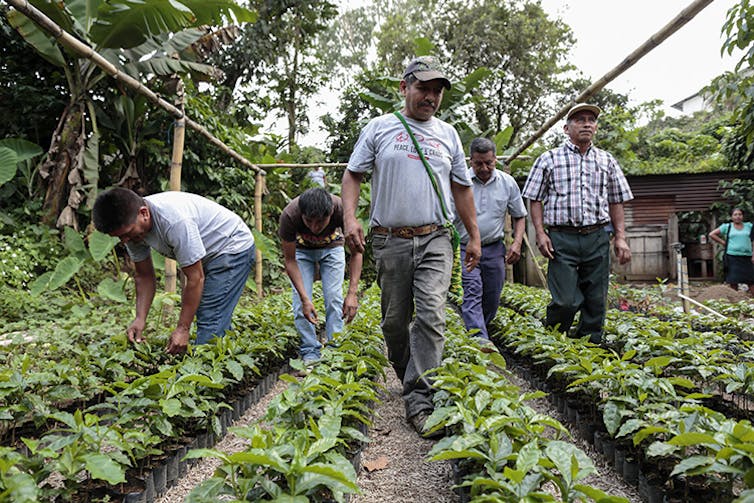Coffee is one of the world’s favourite beverages, a cherished source of caffeine, and many people can’t imagine starting the day without a cup or three.
Times should be good for the coffee industry, with nearly 160 million bags produced in 2018 – up more than 50% compared to 2003. However, the wholesale price per pound peaked in 2011, and has since fallen strongly, raising concerns of a potential crisis.
So what’s happening in coffee-producing and -consuming countries, and what are the impacts?
Coffee market at a glance
The global coffee industry is valued at over $90 billion and is projected to grow at 5.5% annually until 2024. As reported by the Coffee Barometer report, the market is highly consolidated, with 35% of world’s coffee being handled by 10 major roasters, including Nestle, JAB, Starbucks and Lavazza.
While per-person consumption in the United States actually peaked in 1946 – global demand has been pushed forward by urbanisation and the adoption of westernized lifestyles. Consumer tastes are changing, and new ways to enjoy coffee are constantly being invented.

Historically, the biggest coffee lovers are concentrated in developed countries. Finland is an absolute champion, with per-person consumption of more than 12kg coffee per year. Their neighbours in Sweden, Norway, Iceland and Denmark are close on their heels, with more than 8kg consumed annually per person. For future growth, all eyes are focused on emerging countries. China is traditionally a tea-drinking nation and consumes an average of just 3 cups per person per year, but the market has experienced 16% annual growth over the last decade.
Despite some bright spots on the global horizon, however, the coffee industry is facing a surplus of beans for the second consecutive year and that spells trouble.
Brazilian coffee boom
Coffee production is almost exclusively located in developing nations. South America remains the leading region, with 81.5 million bags produced in 2018. Brazil is often referred to as the “Saudi Arabia of coffee”, and as the world’s leading producer, it is responsible for one third of global output and contributes to 25% of the coffee trade. Logically, its production and policies have great influence over the price.
Brazil had a record production year in 2018, with 62 million bags produced. Since coffee is traded in dollars, exports were additionally boosted by the depreciated real, Brazil’s currency. This enabled the country’s traders to earn even more in local currency for every pound of coffee sold abroad. With beans from Brazil flooding the market, oversupply knocked the price of Arabica to less than $1 a pound.

Moreover, Brazilian farmers have found ways to “grow more for less” and have no intention of pulling back, despite the price drop. When times were good, farms in the “coffee belt” used profits from previous years to replace low-yielding trees, expand plantations, and invest in mechanisation and irrigation systems. While farmers admit that overproduction is hurting profits, coffee remains more lucrative than other legal crops.
Estimates for 2019 indicate that Brazilian production should fall to 53 million bags – nearly a 15% drop – it still represents an extraordinarily high quantity for an “off” year and is unlikely to bring relief to the current market oversupply.
Uncertainty in Central America
In Guatemala, coffee cultivation represents the sole source of revenue for many households. With falling prices, however, most farmers have been operating at a loss since 2017, leaving many farms abandoned. In the past nine months, more than 211,000 migrants have attempted to cross the border, making Guatemala the single largest source of migration toward the United States. A similar trend has been evident in Honduras, the world’s fifth-largest coffee producer.

Columbia has also been affected, with some coffee farmers turning toward coca cultivation. As reported by the UN, coca cultivation in Columbia has been steadily increasing, from 48,000 hectares in 2013 to a record high of 200,000 hectares in 2018.
Concerns are also looming among East African coffee exporters, as they struggle to cope with dropping revenues. Earnings for Tanzania and Uganda dropped by 20% compared to the past year, while Kenya has a less dramatic fall of 6%. One way to try to maintain income would be to boost domestic coffee consumption, which remains low across East Africa at less than 7% of total output. An exception is Ethiopia, which is both Africa’s biggest coffee producer and consumer, representing 29% the African market.
What about the price of your coffee?
While farmers and producing countries are feeling the pressure, falling coffee prices should be a boon to consumers – cheaper wholesale coffee means cheaper lattes, right?
No, the reason being that coffee itself represents only a fragment of what’s in your cup. The biggest portion is frequently related to labour costs and local currency rates, as well the location and ambience of the café. Using just a single brand, Starbucks, its tall latte is twice as expensive in India than it is in France when considered in relation to the costs of other goods.

Unequal risks and benefits
While small producers take the biggest risks, they receive only a fraction of profits – the biggest margins in the industry remain in the hands of roasters.
Initiatives such as Fairtrade allow certified farmers to have a Fairtrade Minimum Price, which aims to cover at least the production costs. Although, this represents an important step towards a more balanced income distribution, it is not sufficient.
Xaver Kitzinger, co-founder of Kaffee-Kooperative from Germany points out that “Fairtrade is good but it is just a better way in an unfair market system. You have to change the rules completely to make a difference to the farmers.” He argues that redefining supply chain could be one of the solutions. Supporting this position, Vega Coffee has its roasting center in Nicaragua and does everything locally. All phases of coffee production – from picking and washing, to roasting and packaging are done by farmers. According to Vega, this allows them to earn “up to $11 per kilogram”, but for an entirely finalized product.
Other coffee companies have sustainable development programs in place. Starbucks, for example, highlights that it has invested over $100 million in various support programs. These include C.A.F.E. practices focusing on ethical sourcing and Farmer Support Centers where growers work alongside experts to increase productivity. Also, through its emergency relief funding, the company dedicated $20 million in 2018 to its suppliers in Mexico, El Salvador, Nicaragua and Guatemala to soften the impact of the price drop.
Still, even the biggest players acknowledge that a more structural action needs to be taken across the industry. Nestle highlighted that “addressing underlying issues to the current crisis is beyond the scope of any one company’s actions”.
Is it time for more market regulation?
In the wake of World Coffee Producers Forum in Campinas on July 10th, largest coffee groups from Brazil and Colombia met to address current concerns. In a joint statement, they reflected on the importance of sustainable-development initiatives, but also urged for more market transparency. One of the topics on the table was the need for possible government intervention and more market regulation in order to filter out speculators who, according to growers, distort market prices.
Some might look for inspiration in recent events in the cocoa market. On June 9th 2019, Ivory Coast and Ghana, responsible for two-thirds of the global cocoa production, announced a common price floor of $2,600 a tonne below which the commodity will not sell in the season 2020/2021. The decision was then revised in July with the introduction of a new pricing mechanism. It will include a “fixed living income differential of $400 a tonne” to be applied on top of the selling price of cocoa on the international markets.
But others warn that introducing coffee price floor will not resolve the problem of oversupply – in fact, it could make it worse. If supply continues to grow, boosting local consumption in coffee-growing nations could be one of the ways to balance the market. Brazil already has a strong coffee culture, and there is room for growth in other producing countries as well as emerging markets.
One thing is certain: to secure the future of coffee, additional efforts from all stakeholders will be required.

